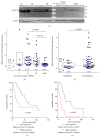Oncosuppressive Role of RUNX3 in Human Astrocytomas
- PMID: 31467531
- PMCID: PMC6699290
- DOI: 10.1155/2019/1232434
Oncosuppressive Role of RUNX3 in Human Astrocytomas
Abstract
Background: Gliomas are the most common and aggressive among primary malignant brain tumours with significant inter- and intratumour heterogeneity in histology, molecular profile, and patient outcome. However, molecular targets that could provide reliable diagnostic and prognostic information on this type of cancer are currently unknown. Recent studies show that certain phenotypes of gliomas such as malignancy, resistance to therapy, and relapses are associated with the epigenetic alterations of tumour-specific genes. Runt-related transcription factor 3 (RUNX3) is feasible tumour suppressor gene since its inactivation was shown to be related to carcinogenesis.
Aim: The aim of the study was to elucidate RUNX3 changes in different regulation levels of molecular biology starting from epigenetics to function in particular cases of astrocytic origin tumours of different grade evaluating significance of molecular changes of RUNX3 for patient clinical characteristics as well as evaluate RUNX3 reexpression effect to GBM cells.
Methods: The methylation status and protein expression levels of RUNX3 were measured by methylation-specific PCR and Western blot in 136 and 72 different malignancy grade glioma tissues, respectively. Lipotransfection and MTT were applied for proliferation assessment in U87-MG cells.
Results: We found that RUNX3 was highly methylated and downregulated in GBM. RUNX3 promoter methylation was detected in 69.4% of GBM (n=49) as compared to 0 to 17.2% in I-III grade astrocytomas (n=87). Weighty lower RUNX3 protein level was observed in GMB specimens compared to grade II-III astrocytomas. Correlation test revealed a weak but significant link among Runx3 methylation and protein level. Kaplan-Meier analysis showed that increased RUNX3 methylation and low protein level were both associated with shorter patient survival (p<0.05). Reexpression of RUNX3 in U87-MG cells significantly reduced glioma cell viability compared to control transfection.
Conclusions: The results demonstrate that RUNX3 gene methylation and protein expression downregulation are glioma malignancy dependent and contribute to tumour progression.
Conflict of interest statement
The authors declare that there are no conflicts of interest regarding the publication of this paper.
Figures



References
LinkOut - more resources
Full Text Sources

